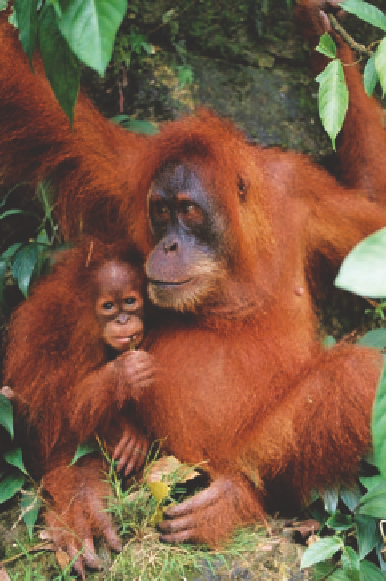Environmental Engineering Reference
In-Depth Information
Figure 8-4
Natural capital degradation:
endan-
gered orangutans in a tropical forest in Gunung
Leuser National Park, Indonesia. In 1900 there were
over 315,000 wild orangutans. Now there are less
than 20,000.and they are disappearing at a rate of
over 2,000 individuals a year.
Figure 8-5
Natural capital:
many species of
wildlife, such as this scarlet macaw in Brazil's
Amazon rainforest, are a source of beauty and plea-
sure. These and other colorful species of parrots can
become endangered when they are removed from
the wild and sold (sometimes illegally) as pets.
lands. These forests, which are managed by the U.S.
Forest Service (USFS), are used for logging, mining,
livestock grazing, farming, oil and gas extraction,
recreation, hunting, fishing, and conservation of wa-
tershed, soil, and wildlife resources.
The Bureau of Land Management (BLM) manages
National Resource Lands
. These lands are used primar-
ily for mining, oil and gas extraction, and livestock
grazing.
The U.S. Fish and Wildlife Service (USFWS) man-
ages the nation's 542
National Wildlife Refuges
. Most
refuges protect habitats and breeding areas for water-
fowl and big game to provide a harvestable supply for
hunters; a few protect endangered species from ex-
tinction. Permitted activities in most refuges include
hunting, trapping, fishing, oil and gas development,
mining, logging, grazing, some military activities, and
farming.
Uses of some other public lands are more re-
stricted. Consider the
National Park System
managed by
8-2 PUBLIC LANDS IN THE
UNITED STATES
Using and Preserving Natural Capital:
U.S. Public Lands
More than one-third of the land in the United States
consists of publicly owned national forests, resource
lands, parks, wildlife refuges, and protected
wilderness areas.
No nation has set aside as much of its land for public
use, resource extraction, enjoyment, and wildlife as
has the United States. The federal government man-
ages roughly 35% of the country's land, which ulti-
mately belongs to every American. About 73% of this
federal public land is in Alaska and another 22% is in
the western states (Figure 8-6, p. 158).
Some federal public lands are used for many pur-
poses. For example, the
National Forest System
consists
of 155 forests (Figure 5-19, bottom, p. 93) and 22 grass-



